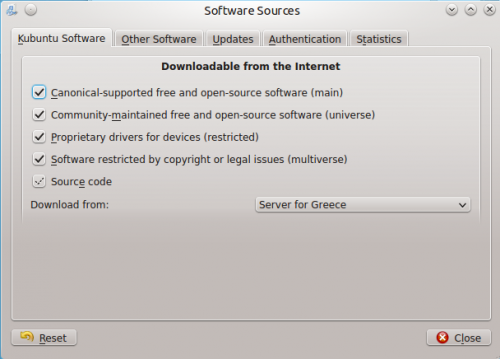Tutorials/Install KDE software/ru: Difference between revisions
Created page with "Вам будет предложено ввести пароль учетной записи пользователя, а затем отобразится такое окно:" |
Created page with "Обычно вам не нужно изменять эти параметры. Источники ПО могут быть добавлены во вкладке <menuchoice>..." |
||
| Line 32: | Line 32: | ||
[[Image:Muon_sw_settings.png|center|500px|thumb|Software Sources]] | [[Image:Muon_sw_settings.png|center|500px|thumb|Software Sources]] | ||
Обычно вам не нужно изменять эти параметры. Источники ПО могут быть добавлены во вкладке <menuchoice>Other Software</ menuchoice>, где вы можете щелкнуть на кнопку Добавить и ввести (или скопировать и вставить) адрес источника программного обеспечения в открывшемся диалоговом окне: | |||
[[Image:Muon_add_source.png|center|500px|thumb|After clicking on the "Add" button, type here software source location.]] | [[Image:Muon_add_source.png|center|500px|thumb|After clicking on the "Add" button, type here software source location.]] | ||
Revision as of 13:21, 15 October 2012
Установка программного обеспечения KDE
Для установки программного обеспечения KDE мы рекомендуем использовать ваш дистрибутив. Здесь вы сможете узнать, как найти название и версию вашего дистрибутива.
Использование менеджера пакетов
openSUSE
Вы найдёте инструмент управления пакетами openSUSE во вкладке стартового меню. Откройте ее щелкните на значке чтобы запустить менеджер пакетов.

Используйте поле для поиска чтобы найти пакет, который вы желаете установить; вы можете искать пакет по названию или его описанию, вам нужно вводить только часть его имени. Вам будет представлен список пакетов, совпадающих с вашим запросом. Выберите пакеты для установки и щелкните . Посетите эту страницу для получения дополнительной информации о том, как работать с пакетами и о дистрибутиве openSUSE.
Так же, вы можете использовать KPackageKit для установки ПО в openSUSE.
Ubuntu/Kubuntu
В Kubuntu 12.04 и поздних выпусках для установки ПО по умолчанию используется Muon Software Center. Для предыдущих выпусков используется KPackageKit. Установка приложений для этих выпусков описана в статье KPackageKit. Если вы еще не были обучены как добавлять дополнительные источники программного обеспечения, вы не нуждаетесь в приведенной ниже информации.
Kubuntu уже содержит всё, что вам понадобится, но если вам необходимо добавить еще один источник программного обеспечения, нужно выбрать .

Вам будет предложено ввести пароль учетной записи пользователя, а затем отобразится такое окно:

Обычно вам не нужно изменять эти параметры. Источники ПО могут быть добавлены во вкладке
[[Image:Muon_add_source.png|center|500px|thumb|After clicking on the "Add" button, type here software source location.]]
=== Fedora ===
<code>yumex</code> will start the graphical package manager. When you start it, the first thing it will do is check to see whether you need any updates. Usually it is best to accept all the updates. If you click on Groups above the file list you will see it re-ordered, showing how a group of packages can be installed by a single click. Look for the cursor in the left panel, touching the arrow:
[[Image:PackageManager.png|center|500px|thumb]]
Clicking on the arrow-head rotates it,listing the package options for that group. This is where you can install the base KDE if it wasn't installed originally.
=== Mageia and Mandriva ===
KDE is the default desktop in Mageia and Mandriva. You can install KDE software using '''Mageia/Mandriva Control Center''' (<code>mcc</code>). Just use <menuchoice>Favorites -> Mageia/Mandriva Control Center then go to page and choose . Standalone graphical installer can be launched from KRunner, just enter drakrpm into the input box.

Other distros
Other distros will offer a package manager. You will need to find it from your menu, but once found, one of these descriptions above should have something similar to yours. If in doubt, ask on IRC and someone will help you. If you've never used IRC, here is a guide to starting to chat with other users.
From the command line
If you find that using a package manager is unbearably slow, you will want to use command-line installation. This is much faster, but the disadvantage is that you need to know the exact name of the package you want to install. Each system has helpful commands for searching, for instance, so try using the first word of install command below, with --help appended. As an example, yum --help will list the commands you can use for Fedora, but they are many and can be confusing at first.
openSUSE
With openSUSE you install software using zypper
for example to install KWrite you will open a console and enter
zypper in kwrite. In older installations of openSUSE, yast was used like this: yast -i kwrite. You can still use yast if you prefer.
Ubuntu
With Ubuntu Linux you install software using apt-get. For example to install KWrite you will open a console and enter
sudo apt-get install kwrite
Fedora
Fedora uses yum so to install KWrite you would open a console and type yum install kwrite If you are unsure of the name of a package, you can use yum list with wildcards to see all the packages with a word as part of the package name — for example yum list *network* will list all available packages with "network" as part of the name. Casting even wider, yum search mpeg will list all packages that either have mpeg in the name or in the description of the package.
Mageia and Mandriva
You can use urpmi to install KDE software from a command line. Other useful commands can be found at Wikipedia's Urpmi page

